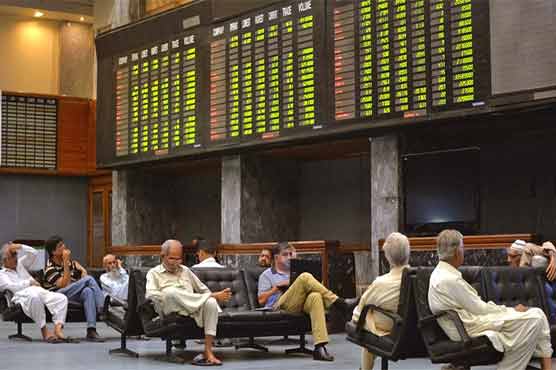Bull run continues as stocks jump 836.57 points

Market activity improved significantly as exports of Pakistan have surpassed $2 billion in Nov 2019.
KARACHI (Dunya News) – Amid reports that investors have restored confidence in Pakistan’s stock market, the KSE-100 index propelled by massive 836.57 points and stormed past the 40,000-level for the first time since February 22, 2019. The benchmark KSE 100-share Index rose to 40,124 points.
The index carried on its upward trajectory by gaining 836 points to close at 40,124 level as Moody s changed Pakistan s outlook to stable from negative, affirming B3 rating.
Market activity improved significantly as the exports of Pakistan have surpassed $2 billion in November 2019, resulting in shrinkage in trade deficit by $988 million.
A heavy volume of 557 million shares was traded today after the highest closing record of around 606 million shares set on May 24, 2017.
Gaining 856.47 points, the benchmark KSE-100 Index recorded its intraday high at 40,144.12 (crossing the 40,000-mark after a period of 10 months). The index settled higher by 836.57 points at 40,124.22. The KMI-30 Index appreciated by 513.30 points or 0.81pc to end at 63,227.25, while the KSE All Share Index gained 432.93 points, closing at 28,271.45.
The overall trading volumes surged to 557.39 million on Monday. The Bank of Punjab (BOP +6.71pc) led the volume chart, followed by K-Electric Limited (KEL +9.29pc) and Unity Foods Limited (UNITY +0.99pc). The scripts had exchanged 74.93 million, 40.85 million and 37.70 million shares, respectively.
Sectors that helped the index accumulate gains included banking (+515.90 points), power generation & distribution (+72.57 points) and oil & marketing (+52.84 points). On the other hand, the oil & gas exploration sector (-83.45 points) continued to hurt the index.
The banking sector gained +4.52pc in its total market capitalization. Habib Bank Limited (HBL +5.00pc), MCB Bank Limited (MCB +5.00pc) and United Bank Limited (UBL +5.00pc) touched their upper circuit breakers.
On Sunday, Adviser to the Prime Minister on Finance Dr Abdul Hafeez Shaikh said the recent strong performance of Pakistan’s stock market was proof of “increasing investor confidence on stabilisation measures” employed by the Pakistan Tehreek-e-Insaf (PTI)-led government.
In a tweet, the premier’s aide stated that the 14.9 per cent gain of the KSE-100 Index in November was the highest one-month return over the past six years.
“The KSE-100 index is up by 14.9% in November 2019, highest one month return after May 2013. Since 16 August 2019, the index increased by 36.6% (10,500 points),” said Mr Shaikh.
The KSE-100 index is up by 14.9% in November 2019, highest one month return after May 2013. Since 16 August 2019, the index increased by 36.6% (10,500 points). The strong rally in Stock Market shows increasing investor confidence on stabilisation measures taken by the Govt.
- Dr. Abdul Hafeez Shaikh (@a_hafeezshaikh) December 1, 2019
His comments came after the Pakistan Stock Exchange had a phenomenal rally in the outgoing week despite political uncertainty that jolted investors briefly.
According to updates till Friday, the benchmark KSE-100 index managed to sustain its winning streak for the fifth successive week as it advanced 1,362 points or 3.59 per cent and crossed the 39,000 mark after eight months. It closed the week at 39,288 points.
“In November 2019, the KSE-100 index increased 5,084 points or 14.9pc month-on-month – this is the highest monthly return after May 2013,” said AHL Research in its report.
Earlier, State Bank of Pakistan Governor Reza Baqir had hinted at maintaining the status quo in the monetary policy, which provided much-needed clarity and helped the bourse trade in the green zone.
In the monetary policy announcement, the State Bank of Pakistan (SBP) has kept the interest rate unchanged at 13.25pc.
Foreign investment in government backed treasury bills was recorded at almost USD 800 million since the beginning of FY20, attributable to waning concerns on the economic front has effectively supported the slight growth in FX reserves of the SBP and consequentially, kept the exchange rate parity stable.
The state bank had said market sentiment has begun to gradually improve on the back of sustained improvements in the current account and continued fiscal prudence.
It had said that the current account balance recorded a surplus in October 2019 after a gap of four years, a clear indication of receding pressures on the country’s external accounts together with the end of deficit monetisation has qualitatively improved the inflation outlook.
It had outlined that recent economic data suggest that economic activity is strengthening in export oriented and import competing sectors while inward oriented sectors continue to experience a slowdown in activity.
Specifically, large-scale manufacturing (LSM) shows gains in electronics, engineering goods and fertilizer sectors and decline in auto, food, and construction allied industries of steel and cement.
The external sector continued to show steady improvement, reflecting the benefits of recent policy adjustments and other factors. In the first four months of the current fiscal year, the current account deficit contracted by 73.5 percent to 1.5 billion dollars.
This improvement reflected a notable reduction in imports, a modest growth in exports and steady workers’ remittances.

